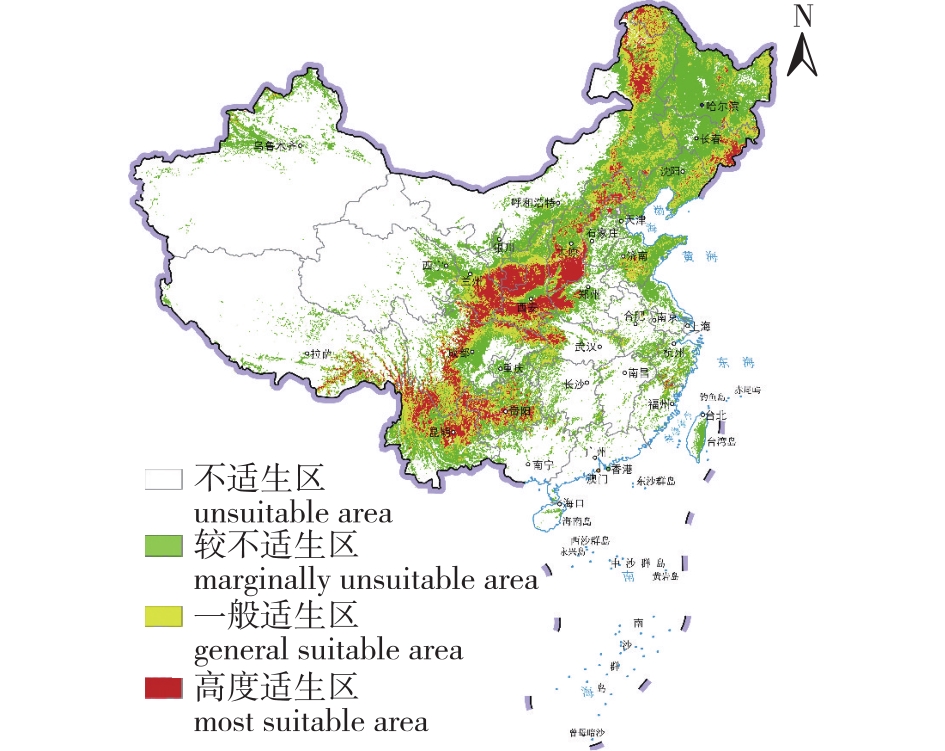 PDF(3857 KB)
PDF(3857 KB)


Modelling the potential distribution area of Populus davidiana in China based on the Biomod2
GAO Minglong, TIE Niu, ZHANG Chen, LI Fengzi, WU Yahan, LUO Qihui, WANG Zirui, LIU Lei, SA Rula
Journal of Nanjing Forestry University (Natural Sciences Edition) ›› 2024, Vol. 48 ›› Issue (2) : 247-255.
 PDF(3857 KB)
PDF(3857 KB)
 PDF(3857 KB)
PDF(3857 KB)
Modelling the potential distribution area of Populus davidiana in China based on the Biomod2
【Objective】 This study aims to investigate the effects of changes in environmental factors on the distribution of Populus davidiana, and to provide theoretical support for the conservation and development of P. davidiana resources. 【Method】 This study applied Biomod2 to simulate changes in the spatial distribution pattern of P. davidiana in China's potential distribution areas under three future climatic conditions based on 134 geographical distribution data points of P. davidiana in China, combined with 18 climatic, soil and topographic factors. Then a combinatorial model based on the Biomod2 package was consturcted and identified the main environmental variables affecting the distribution of P. davidiana were identified. 【Result】 The current potential distribution areas of P. davidiana in China were mainly located at higher latitudes or higher altitudes on both sides of the 400 mm precipitation line, with a total area of about 1 560 340.9 km2, of which the Greater Khingan Mountains, Changbai Mountains, Taihang Mountains, Qinling Mountains, southern foot of Qilian Mountains, Hengduan Mountains, Yunnan-Guizhou Plateau and other areas are the highest suitable areas for P. davidiana. Under future climatic conditions, the overall trend of suitable areas for P. davidiana will shrink to southwest China, and the overall trend of suitable areas was decreasing. The ensemble model constructed based on the five optimal single models had better prediction results for suitable areas for P. davidiana compared to the single model, and the area under the receiver operating characteristic curve and true skill statistics were distributed as 0.91 and 0.73, with higher prediction accuracy. 【Conclusion】 The spatial distribution pattern of P. davidiana in China was mainly influenced by water and heat conditions, while altitude was also an important factor affecting its distribution. Under future climatic conditions, the area of P. davidiana distribution will gradually decrease based on the degree of climate warming. When planting P. davidiana for timber forests and as an ecological public welfare forest species, planting sites should be selected in areas where habitat suitability will not change significantly in the future, to reduce future losses because of climate change.

Populus davidiana / Biomod2 / ensemble model / potential distribution area / global warming
| [1] |
曾建平, 代峰. 气候伦理是否可能[J]. 中国人民大学学报, 2011, 25(3):90-96.
|
| [2] |
|
| [3] |
|
| [4] |
|
| [5] |
|
| [6] |
刘晓彤, 袁泉, 倪健. 中国植物分布模拟研究现状[J]. 植物生态学报, 2019, 43(4):273-283.
|
| [7] |
|
| [8] |
|
| [9] |
赵光华, 崔馨月, 王智, 等. 气候变化背景下我国酸枣潜在适生区预测[J]. 林业科学, 2021, 57(6):158-168.
|
| [10] |
|
| [11] |
吴晓萌, 叶冬梅, 白玉娥, 等. 基于MaxEnt模型的中国白杄分布格局及未来变化[J]. 西北植物学报, 2022, 42(1):162-172.
|
| [12] |
|
| [13] |
|
| [14] |
卫尊征, 郭丽琴, 张金凤, 等. 利用trnL-F序列分析杨属树种的系统发育关系[J]. 北京林业大学学报, 2010, 32(2):27-33.
|
| [15] |
中国科学院中国植物志编辑委员会. 中国植物志-第二十卷, 第二分册[M]. 北京: 科学出版社,1984.
Delectis Florae Reipublicae Popularis Sinicae, Agendae Academiae Sinicae Edita. Flora reipublicae popularis sinicae tomus 20(2)[M]. Beijing: Science Press,1984.
|
| [16] |
翁宇威, 蔡闻佳, 王灿. 共享社会经济路径(SSPs)的应用与展望[J]. 气候变化研究进展, 2020, 16(2):215-222.
|
| [17] |
|
| [18] |
张天蛟, 刘刚. 提高生态位模型时间转移能力的方法研究[J]. 中国农业大学学报, 2017, 22(2):98-105.
|
| [19] |
|
| [20] |
|
| [21] |
吴艺楠, 马育军, 刘文玲, 等. 基于BIOMOD的青海湖流域高原鼠兔分布模拟[J]. 动物学杂志, 2017, 52(3):390-402.
|
| [22] |
郭恺琦, 姜小龙, 徐刚标. 薄片青冈潜在适生区及气候变化对其分布的影响[J]. 生态学杂志, 2021, 40(8):2563-2574.
|
| [23] |
|
| [24] |
李易. 中国山杨群体历史动态初步研究[D]. 北京: 中国林业科学研究院, 2020.
|
| [25] |
郭彦龙, 赵泽芳, 乔慧捷, 等. 物种分布模型面临的挑战与发展趋势[J]. 地球科学进展, 2020, 35(12):1292-1305.
|
| [26] |
袁喆, 严登华, 杨志勇, 等. 1961—2010年中国400 mm和800 mm等雨量线时空变化[J]. 水科学进展, 2014, 25(4):494-502.
|
| [27] |
贺敏, 魏江生, 石亮, 等. 大兴安岭南段山杨径向生长和死亡对区域气候变化的响应[J]. 生态学杂志, 2018, 37(11):3237-3244.
|
| [28] |
潘春芳, 赵秀海, 夏富才, 等. 长白山山杨种群的性比格局及其空间分布[J]. 生态学报, 2011, 31(2):297-305.
|
| [29] |
|
| [30] |
|
| [31] |
白伟宁, 张大勇. 植物亲缘地理学的研究现状与发展趋势[J]. 生命科学, 2014, 26(2):125-137.
|
| [32] |
|
| [33] |
|
| [34] |
|
| [35] |
胡忠俊, 张镱锂, 刘林山, 等. 生物避难所及其识别方法评述[J]. 生态学杂志, 2013, 32(12):3397-3406.
|
/
| 〈 |
|
〉 |